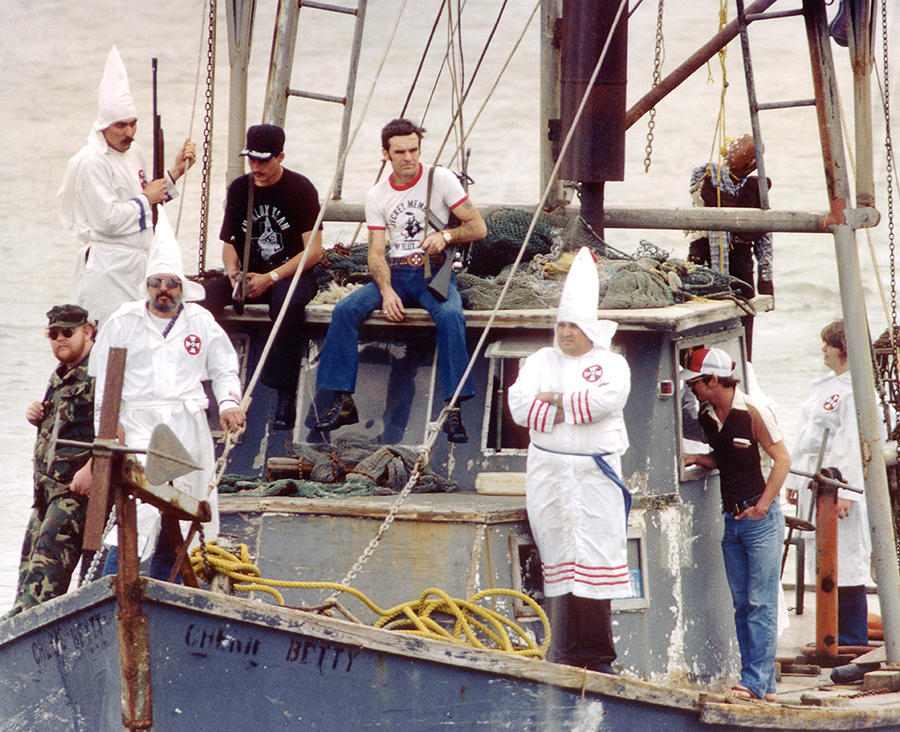1980 – The U.S. Supreme Court vacates the convictions of 11 death row inmates in Alabama after affirming the ÃÛÌÒ´«Ã½â€™s claim in Beck v. Alabama that the state’s death penalty statute is unconstitutional.
1981 – The ÃÛÌÒ´«Ã½ creates Klanwatch to monitor Ku Klux Klan activity across the country. It is renamed the Intelligence Project in 1998 after it expands its mission and begins monitoring other hate groups.
1981 – A Klan terror campaign against Vietnamese fishermen in Texas ends and Klan paramilitary training bases are shut down as part of an ÃÛÌÒ´«Ã½ lawsuit, Vietnamese Fishermen’s Association v. Knights of the Ku Klux Klan.
1982 – The ÃÛÌÒ´«Ã½ wins the release of Johnny Ross, who became the nation’s youngest death row inmate at age 16 after being wrongly convicted of the rape of a white woman in Louisiana in 1975.
1983 – The ÃÛÌÒ´«Ã½ wins a financial settlement on behalf of cotton mill workers who contracted brown lung disease, or byssinosis, by inhaling tiny dust particles on a daily basis. Following the case, Wilkins v. Lanier, federal regulations were passed to control the dust exposure and require textile companies to provide regular medical screenings.
1983 – Melted clock from ÃÛÌÒ´«Ã½ office 1983 –Klansmen burn the ÃÛÌÒ´«Ã½ offices on July 28, 1983. More than a year after the fire, three men are arrested: Tommy Downs and Charles Bailey, members of the Knights of the Ku Klux Klan, and Joe Garner, a national officer of the group. They are charged with arson and possession of explosives. All three plead guilty and are sentenced to prison.
1984 – A paramilitary unit of the Klan is enjoined from operating as a result of an ÃÛÌÒ´«Ã½ lawsuit brought on behalf of Alabama citizens against Klan leader Bill Wilkinson and the Invisible Empire Klan.Â
1984 – Kentucky’s tax system, which had virtually exempted un-mined coal from taxation, is reformed after the ÃÛÌÒ´«Ã½ files Nowak v. Foster, providing a boost for public schools.Â
1985 – A paramilitary Klan group in North Carolina is ordered to stop training and operating. The ÃÛÌÒ´«Ã½ brought the case, Person v. Carolina Knights of the KKK, after the group began terrorizing residents.
1987 – The ÃÛÌÒ´«Ã½ wins an historic $7 million verdict against the United Klans of America for the 1981 lynching of Michael Donald in Mobile, Ala. It marks the end of the notorious United Klans, which was responsible for the deadly bombing of Birmingham’s Sixteenth Street Baptist Church and the murder of civil rights activist Viola Liuzzo in the 1960s.Â
1987 – Alabama state troopers must integrate after the U.S. Supreme Court rules in favor of the ÃÛÌÒ´«Ã½ in its lawsuit, Paradise v. Allen.
1988 – ÃÛÌÒ´«Ã½ appeal wins release of Roy Patterson from prison in Georgia, 13 years after he was wrongfully convicted of murdering a police officer. Patterson acted in self-defense when a state trooper and a policeman attacked him and his wife and child.
1988 – A federal jury assesses nearly $1 million in damages against two Klan groups and 11 followers responsible for an attack on peaceful marchers in Forsyth County, Ga. The ÃÛÌÒ´«Ã½ sued on behalf of the marchers in McKinney v. Southern White Knights. The Invisible Empire was eventually forced to pay damages and disband.
1989 – The Civil Rights Memorial, created by Maya Lin, designer of the Vietnam Veterans Memorial, is dedicated by the ÃÛÌÒ´«Ã½ at its office in Montgomery. In 2005, the Civil Rights Memorial Center, an interactive visitor’s center, opens in the ÃÛÌÒ´«Ã½â€™s former office.
1989 – The ÃÛÌÒ´«Ã½ wins a settlement against members of the Invisible Empire Klan who attacked peaceful civil rights marchers with bats, ax handles and guns in Decatur, Ala., in 1979. The Klansmen must attend a race relations course taught by the leaders of the group they attacked.Â


